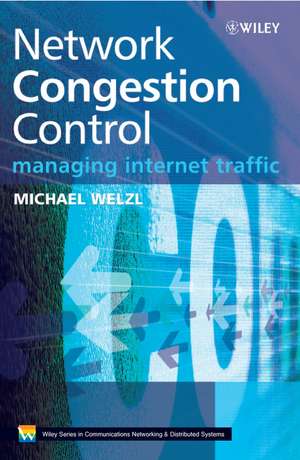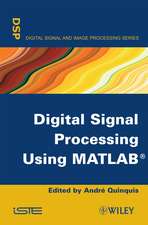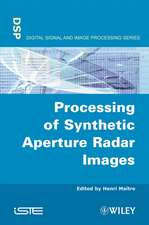Network Congestion Control – Managing Internet Traffic: Wiley Series on Communications Networking & Distributed Systems
Autor M Welzlen Limba Engleză Hardback – 27 iul 2005
Din seria Wiley Series on Communications Networking & Distributed Systems
- 9%
 Preț: 725.77 lei
Preț: 725.77 lei - 9%
 Preț: 1005.76 lei
Preț: 1005.76 lei - 8%
 Preț: 502.37 lei
Preț: 502.37 lei - 8%
 Preț: 670.95 lei
Preț: 670.95 lei - 8%
 Preț: 564.34 lei
Preț: 564.34 lei - 32%
 Preț: 561.26 lei
Preț: 561.26 lei - 32%
 Preț: 606.40 lei
Preț: 606.40 lei - 31%
 Preț: 618.83 lei
Preț: 618.83 lei - 32%
 Preț: 733.99 lei
Preț: 733.99 lei - 32%
 Preț: 749.45 lei
Preț: 749.45 lei - 31%
 Preț: 613.78 lei
Preț: 613.78 lei - 32%
 Preț: 644.42 lei
Preț: 644.42 lei - 31%
 Preț: 505.24 lei
Preț: 505.24 lei - 30%
 Preț: 421.34 lei
Preț: 421.34 lei - 32%
 Preț: 564.48 lei
Preț: 564.48 lei - 32%
 Preț: 518.98 lei
Preț: 518.98 lei - 31%
 Preț: 678.16 lei
Preț: 678.16 lei - 26%
 Preț: 329.57 lei
Preț: 329.57 lei - 31%
 Preț: 542.09 lei
Preț: 542.09 lei - 31%
 Preț: 479.65 lei
Preț: 479.65 lei
Preț: 782.82 lei
Preț vechi: 860.23 lei
-9% Nou
Puncte Express: 1174
Preț estimativ în valută:
149.83€ • 155.83$ • 125.56£
149.83€ • 155.83$ • 125.56£
Carte tipărită la comandă
Livrare economică 13-27 martie
Preluare comenzi: 021 569.72.76
Specificații
ISBN-13: 9780470025284
ISBN-10: 047002528X
Pagini: 282
Dimensiuni: 172 x 251 x 21 mm
Greutate: 0.68 kg
Ediția:New.
Editura: Wiley
Seria Wiley Series on Communications Networking & Distributed Systems
Locul publicării:Chichester, United Kingdom
ISBN-10: 047002528X
Pagini: 282
Dimensiuni: 172 x 251 x 21 mm
Greutate: 0.68 kg
Ediția:New.
Editura: Wiley
Seria Wiley Series on Communications Networking & Distributed Systems
Locul publicării:Chichester, United Kingdom
Public țintă
Advanced networking and Internet courses, researchers in CS and EE communications networking. Also suitable for Network administrators, ISPs, application providers.Cuprins
Foreword.
Preface.
List of Tables.
List of Figures.
1. Introduction .
1.1 Who should read this book?
1.2 Contents.
1.3 Structure.
2. Congestion control principles.
2.1 What is congestion?
2.2 Congestion collapse.
2.3 Controlling congestion: design considerations.
2.4 Implicit feedback.
2.5 Source behaviour with binary feedback.
2.6 Stability.
2.7 Rate-based versus window-based control.
2.8 RTT estimation.
2.9 Traffic phase effects.
2.10 Queue management.
2.11 Scalability.
2.12 Explicit feedback.
2.13 Special environments.
2.14 Congestion control and OSI layers.
2.15 Multicast congestion control.
2.16 Incentive issues.
2.17 Fairness.
2.18 Conclusion.
3. Present technology.
3.1 Introducing TCP.
3.2 TCP window management.
3.3 TCP RTO calculation.
3.4 TCP congestion control and reliability.
3.5 Concluding remarks about TCP.
3.6 The Stream Control Transmission Protocol (SCTP).
3.7 Random Early Detection (RED).
3.8 The ATM'Available Bit Rate' service.
4. Experimental enhancements.
4.1 Ensuring appropriate TCP behaviour.
4.2 Maintaining congestion state.
4.3 Transparent TCP improvements.
4.4 Enhancing active queue management.
4.5 Congestion control for multimedia applications.
4.6 Better-than-TCP congestion control.
4.7 Congestion control in special environments.
5. Internet traffic management - the ISP perspective.
5.1 The nature of Internet traffic.
5.2 Traffic engineering.
5.3 Quality of Service (QoS).
5.4 Putting it all together.
6. The future of Internet congestion control.
6.1 Small deltas or big ideas?
6.2 Incentive issues.
6.3 Tailor-made congestion control.
Appendix A: Teaching congestion control with tools.
A.1 CAVT.
A.1.1 Writing script.
A.1.2 Teaching with CAVT.
A.1.3 Internals.
A.2 ns.
A.2.1 Using ns for teaching: the problem.
A.2.2 Using ns for teaching: the solution.
A.2.3 NSBM.
A.2.4 Example exercises.
Appendix B: Related IETF work.
B.1 Overview.
B.2 Working groups.
B.3 Finding relevant documents.
Appendix C: List of abbreviations.
Bibliography.
Index.
Descriere
As the Internet becomes increasingly heterogeneous, the issue of congestion control becomes ever more important. In order to maintain good network performance, mechanisms must be provided to prevent the network from being congested for any significant period of time.












